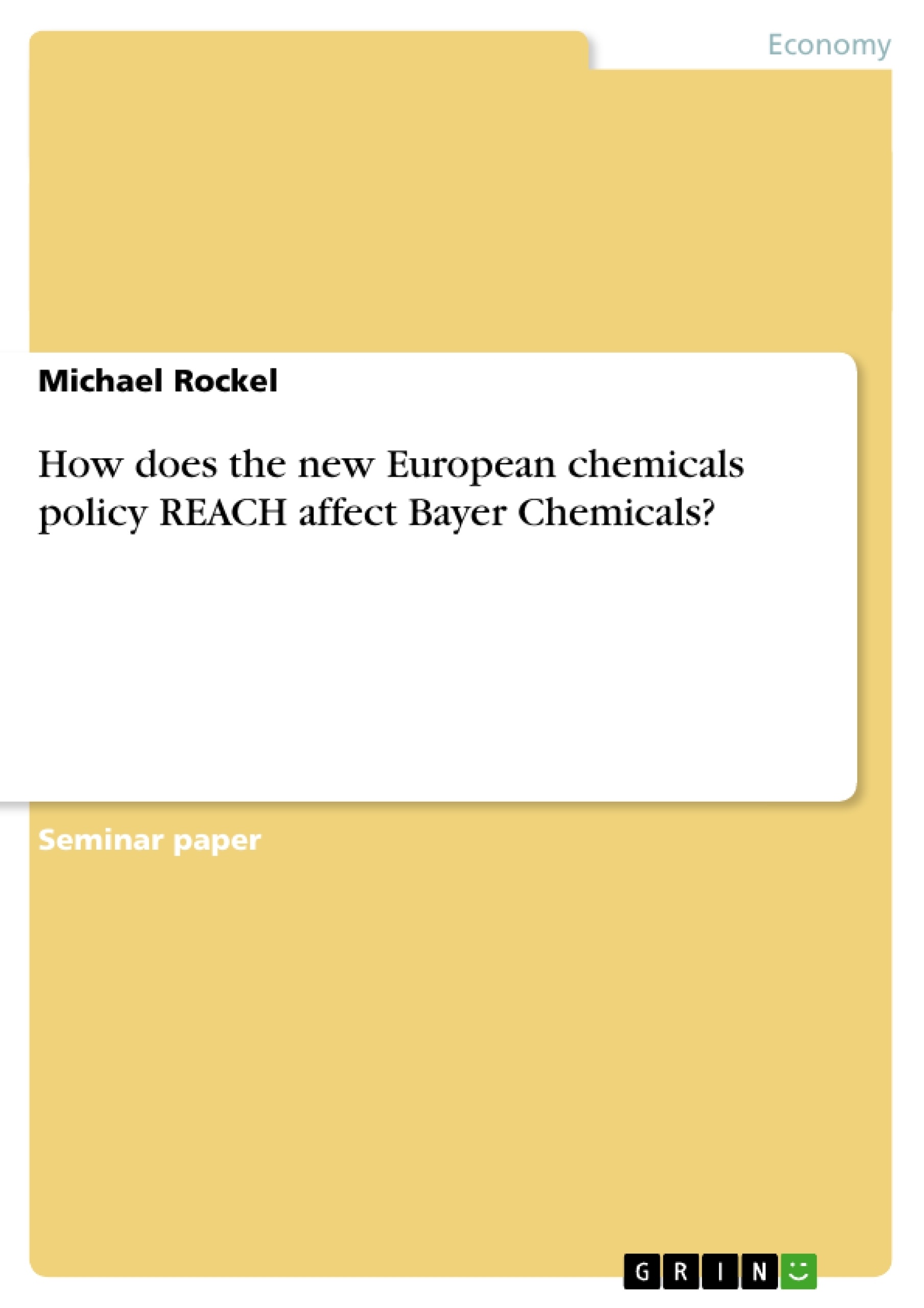With the global business environments slowly recovering from several years of downturn in the markets the question is how competitive Europe is in the future. In Comparison with the three major business regions in the world, Europe is lagging behind. [...] Several experts think that Europe’s chemical industry will not be competitive in the long-run, even though this issue is not mainly a lack of competitiveness as more a matter of the fact, that the necessary growth is just not there (Chemical Market Reporter 2003). The purpose of this report is to stress out the effects of the implementation of the new European chemicals policy, its relevance for the competitiveness of the Europe and it’s the effects on Bayer Chemicals AG.
Table of contents
Table of figures
1 Introduction
The REACH System
1.1 Elements
1.2 Strategy and objectives
1.3 Implementation Timeline
2 The scope of the REACH-Regulation
3 Effects of REACH on Bayer Chemicals
3.1 Bayer Chemicals
3.2 Effects on Bayer Chemicals
3.2.1 Direct
3.2.2 Indirect
4 Conclusion & Fazit
Bibliography
Table of figures
Figure 1: Forcasted GDP growth
1 Introduction
With the global business environments slowly recovering from several years of downturn in the markets the question is how competitive Europe is in the future. In Comparison with the three major business regions in the world, Europe is lagging behind.
illustration not visible in this excerpt
Figure 1 : Forcasted GDP growth
Several experts think that Europe’s chemical industry will not be competitive in the long-run, even though this issue is not mainly a lack of competitiveness as more a matter of the fact, that the necessary growth is just not there (Chemical Market Reporter 2003).
The purpose of this report is to stress out the effects of the implementation of the new European chemicals policy, its relevance for the competitiveness of the Europe and it’s the effects on Bayer Chemicals AG.
2 The REACH System
The REACH System or so called “White Paper on the Strategy for a future Chemicals policy” addresses the need to protect the community’s environment from hazardous Chemicals, to support the creation of comparable standards for chemicals to protect consumers and to ensure the free circulation of goods between member states (European Commission 2003).
2.1 Elements
The REACH (Registration, Evaluation and Authorisation) system contains the following Elements.
> Registration: Manufactures must provide information (basic hazard, exposure, risk information) about substances that are produced or sold in quantities larger than one ton annually.
> Evaluation: Authorities will evaluate risk for substances that are produced or imported in quantities greater than 100 tons and decide if further steps are necessary.
> Authorization: About 1400 substances of very high concern will need permissions for particular use.
The REACH-system shifts the load of finding potentially risky chemicals from the authorities to the industry. The companies using those chemicals now have to proof, that all chemicals used are harmless (Risk & Policy Analysts Ltd. 2002).
2.2 Strategy and objectives
The main purposes of the new policy are protecting the environment and the health of the people, preserving the competitiveness of the industry, avoiding internal market fragmentation, promoting transparency of the technical product information on chemicals, integrating international chemical safety efforts and assuring the conformance with WTO obligations.
Behind these main objectives, the following main strategic aspects of the policy are visible: Making the industry responsible in providing the commission with chemicals safety information, expanding the responsibility to downstream users of the chemicals, authorising the usage of certain chemicals, stimulating the development of safer chemicals and chemical-processes, providing open access to chemical information and achieving the use of safer chemicals on a global level (Cooper 2003).
2.3 Implementation Timeline
02.2001 The Proposals on the Chemicals Policy have been published by the EU Commission in a draft White Paper.
05.2003 Over two years, the proposal has been adapted and opened to a public Internet Consultation on the workability of the regulations, launched by the Commission.
06.2003 Internet Consultation closes. There have been about 6,500 responses from individual companies; Trade Associations, national Governments, other stakeholder groups and individuals which are being approved and analysed by the Commission and used as a base to make further adjustments to the paper.
09.2003 Interservice consultation between Commissioners, their private offices and the Commission Directorates.
09.2003 Revised proposals are leaked by the Commission.
10.2003 Formal adoption of the proposals by the Commission
11.2003 Co-decision procedure begins
04.2004 The possible first reading in the European Parliament was scheduled for April. This has been postponed for later this year.
2005 Date at which the implementation of
The white paper is scheduled to be established in 2005, from which time on it will be relevant to all European businesses (Hepburn 2003).
[...]
- Quote paper
- Michael Rockel (Author), 2004, How does the new European chemicals policy REACH affect Bayer Chemicals?, Munich, GRIN Verlag, https://www.grin.com/document/35881
-

-

-

-
Upload your own papers! Earn money and win an iPhone X. -

-
Upload your own papers! Earn money and win an iPhone X. -

-
Upload your own papers! Earn money and win an iPhone X. -

-
Upload your own papers! Earn money and win an iPhone X. -

-
Upload your own papers! Earn money and win an iPhone X.

